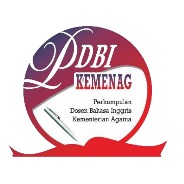Implications of Illocutionary Speech Acts Study in Language Learning for Foreigners
Abstract
Keywords
Full Text:
PDFReferences
Austin, J. (1962). How to Do Things with Words. New York: Oxford University Press.
Bayat, Nihat. (2013). A Study on The Use of Speech Acts. Procedia: Social and Behavioral Sciences, (70), 213—221.
Christianto, Danin. (2020). Speech Acts in EFL Classrooms. Journal of Pragmatics Research, 02 (01), 68—79.
Dwiyanti, T, A., & Mujianto, G. (2021). Tindak Tutur Ilokusi Peserta Didik dalam Pembelajaran Bahasa Indonseia pada SMPN 1 Pujo. Jurnal Ilmiah Bahasa dan Sastra, 5(1).https://jurnal.umk.ac.id/index.php/kredo/article/view/6208
Frandika, E., & Idawati. (2020). Tindak Tutur Ilokusi dalam Film Pendek “Tilik (2018)”. Jurnal Pendidikan Bahasa dan Sastra Inonesia, 3(2). https://jurnal.umj.ac.id/index.php/penaliterasi/article/view/7392
Mirawati, D. (2020). Tindak Tutur Ilokusi Dalam Novel Pastelizze karya Indrayani Rusady dan Implikasinya terhadap Pembelajaran Bahasa Indonesia. Jurnal Pendidkan, Bahasa, Sastra, Seni, dan Budaya, 3(1).
https://e-journal.upr.ac.id/index.php/enggang/article/view/7775
Mayrita, H., Sari, A, P, I., & Mardhotillah, (2022). Kebutuhan Mahasiswa Berbahasa sebagai Bahan Redesain Silabus Mata Kuliah. Susunan Artikel Pendidkan, 18(2). https://journal.lppmunindra.ac.id/index.php/SAP/article/view/13929
Sumarno, (2020). Analisis Isi dalam Penelitian Pembelajaran Bahasa dab Sastra. Edukasi Lingua Sastra, 18(3). https://jurnal.umko.ac.id/index.php/elsa/artticle/view/299
Sagita, R, V., & Setiawan, T. (2019). Bentuk dan Jenis Tindak Tutur Ilokusi Ridwan Kamil dalam Talkshow Insight di CNN Indonesia. Jurnal Kajian Kebahasaan, Kesusastraan, dan Budaya, 9(2).
https://jurnal.unimus.ac.id.index.php/lensa/article/downloadSuppFile/
/375
Spradley, James P. 1997. Metode Etnografi.Yogyakarta: Tiara Wacana.
Widyaningsiih, L. (2021). Analisis Tindak Tutur Ilokusi dalam Film Ada Cinta di SMA Sutradara Patrick Effendy. Jurnal Bahasa, Sastra Indonesia, dan Pengajarannya, 2(2). https://ejuornal.uinsaid.ac.id/index.php/tabasa/announcement
Zaiman, R., & Irama, C, N. (2020). Bentuk Tindak Tutur Ilokusi dalam Dialog Film Wanoja karya Rofie Al Joe. Jurnal Bindo Sastra, 4(2).https://jurnal.um-palembang.ac.id/bisastra/article/view/2800
Zou, Leilei & Yiye. (2022). Review of Research on Development of Speech Act Theory and Its Application. IJLLT: International Journal of Linguistics, Literature, and Translation, 2 (12), 127—135
DOI: http://dx.doi.org/10.29240/ef.v7i2.8037
Refbacks
- There are currently no refbacks.
Copyright (c) 2023 Hastari Mayrita

This work is licensed under a Creative Commons Attribution-NonCommercial-ShareAlike 4.0 International License.
INDEXED BY:
 This work is licensed under a Creative Commons Attribution-NonCommercial-ShareAlike 4.0 International License
This work is licensed under a Creative Commons Attribution-NonCommercial-ShareAlike 4.0 International License
@ ENGLISH FRANCA : Academic Journal of English Language and Education
Jl. Dr. AK Gani No 1 Dusun Curup, Rejang Lebong Regency, Bengkulu Province, Indonesia, 39119.
Dr. Eka Apriani, M.Pd., email: efranca@iaincurup.ac.id, eka.apriani@iaincurup.ac.id.




.png)












